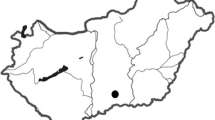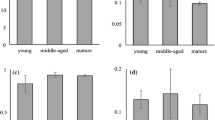Abstract
The absence of large forests and the importance of natural elements for the welfare and health of people, made the Flemish government and the province of eastern Flanders, Belgium, investigate the establishment of one large regional forest out of existing forest remnants. After several studies, the location ‘Makegem forests–Aelmoeseneiebos’ was withheld for future forest expansion. In this study, the spider fauna of five forest remnants from that region was sampled and differences and congruencies in spider diversity and community structure of these fragments were assessed. Our results show that (1) considering the limited forest areas and high degree of fragmentation, the overall observed spider diversity was high, but half of the spiders were non-forest species, (2) half of the encountered Red list species were restricted to only one of the studied woodlands and creating one large forest may be vital for their conservation, (3) diversity–rarefaction curves were higher for the more humid than for the dryer forest sites, and (4) dissimilarities between spider communities are mostly caused by historical factors and humidity and are therefore also linked with the properties of the litter layer and main tree species. We conclude that an expansion of the existing forest remnants will likely maintain or even improve the richness of the spider faunas. Because sufficiently large suitable habitats will develop, several (critical) species may be saved. This is, however, only possible if the characteristic properties of the forests are preserved.
Similar content being viewed by others
References
Bultmann T.L. and Uetz G.W. 1982. Abundance and community structure of forest floor spiders following litter manipulation. Oecologia 55: 34–41.
Colwell R.K. 2000. EstimateS: Statistical Estimation of Species Richness and Shared Species from Samples (Software and User's Guide), Version 6. http://viceroy.eeb.uconn.edu/estimates.
Connor E.F., Courtney A.C. and Yoder J.M. 2000. Individuals–area relationships: the relationship between animal population density and area. Ecology 81: 734–748.
De Bakker D., Desender K. and Grootaert P. 2000. Determination and bioindication of forest bound invertebrates. Part 1. Bioindication of the stand variables. Report ENT.2000.01. Research project B&;G/29/98 (in Dutch).
De Bakker D., Maelfait J.-P., Desender K., Hendrickx F. and DeVos B. 2002. Regional variation in spider diversity of Flemish forest stands. In: Toft S. and Scharff N. (eds), European Arachnology 2000. Aarhus University Press, Aarhus, Denmark, pp. 177–182.
Denslow J. 1995. Disturbance and diversity in tropical rain forests: the density effect. Ecological Applications 5: 962–968.
Desender K. 1996. Diversity and dynamics of coastal dune carabids. Annales Zoologica Fennici 33: 65–75.
Desender K. and Pollet M. 1988. Sampling pasture carabids with pitfalls: evaluation of species richness and precision. Mededelingen Faculteit Landbouwwetenschappen Rijksuniversiteit Gent 53: 1109–1117.
Desender K., Baert L., Maelfait J.-P. and Verdyck P. 1999. Conservation onVolcan Alcedo (Galapagos): terrestrial invertebrates and the impact of introduced feral goats. Biological Conservation 87: 303–310.
Desender K., De Bakker D. and Van de Kerckhove P. 2001. Inventory and determination of invertebrates as ecological indicators in integral forest reserves in Flanders. Part 2. Case study of the influence of forest history, forest fragmentation and forest exploitation on the spider and ground beetle fauna of ecological valuable alluvial forests. Report ENT.2001.03. Research project B&;G/19/99 (in Dutch).
Dufrene M. and Legendre P. 1997. Species assemblages and indicator species: the need for a flexible asymmetrical approach. Ecological Monographs 67: 345–366.
Fahrig L. 2001. How much habitat is enough? Biological Conservation 100: 65–74.
Gotelli N.J. and Colwell R.K. 2001. Quantifying biodiversity: procedures and pitfalls in the measurement and comparison of species richness. Ecology Letters 4: 379–391.
Gotelli N.J. and Entsminger G.L. 2001. Ecosim: Null models software for ecology.Version 7. Acquired Intelligence Inc. &; Kesey-Bear, Burlington, Vermont, http://homepages.together.net/gentsmin/ ecosim.htm.
Gurdebeke S. and Maelfait J.-P. 2002. Pitfall trapping in population genetics studies: finding the right 'solution'. Journal of Arachnology 30: 255–261.
Gurdebeke S., Maelfait J.-P. and Backeljau T. 2003. Contrasting allozyme and RAPD variation in spider populations from patchy forest habitats. Genetica 119 (in press).
Gurdebeke S., Neirynck B. and Maelfait J.-P. 2000. Population genetic effects of forest fragmentation in Flanders (Belgium) on Coelotes terrestris (Araneae: Agelenidae) as revealed by allozymes and RAPD. Ekólogia (Bratislava) 19: 87–96.
Heublein D. 1983. Räumliche Verteilung, Biotoppräferenzen und kleinräumige Wanderungen der epi-gäischen Spinnenfauna eines Wald-Wiesen-Ökotons; ein Beitrag zum Thema ‘Randeffekt’. Zoologisches Jahrbuch Systematic 110: 473–519.
Huhta V. 1965. Ecology of spiders in the soil and litter of Finnish forests. Annales Zoologici Fennici 2: 260–308.
Huhta V. 1971. Succession in the spider communities of the forest floor after clear-cutting and prescribed burning. Annales Zoologici Fennici 8: 483–542.
Hövemeyer K. and Stippich G. 2000. Assessing spider community structure in a beech forest: effects of sampling method. European Journal of Entomology 97: 369–375.
Hurlbert S.H. 1971. The nonconcept of species diversity: a critique and alternative parameters. Ecology 52: 577–586.
Jocqué R. 1973. The spider fauna of adjacent woodland areas with different humus types. Biologisch Jaarboek Dodonaea 41: 153–179.
Jongman R.H.G., Ter Braak C.J.F. and Van Tongeren O.F.R. 1995. Data Analysis in Community and Landscape Ecology. Cambridge University Press, Cambridge, UK.
Junker E.A., Ratschker U.M. and Roth M. 2000. Impacts of silvicultural practice on the ground living-spider community (Arachnida: Araneae) of mixed mountain forests in the Chiemgau Alps (Germany). Ekológia (Bratislava) 19: 107–117.
Kajak A., Kupryjanowicz J. and Petrov P. 2000. Long term changes in spider (Araneae) communities in natural and drained fens in the Biebrza river valley. Ekólogia (Bratislava) 19: 55–64.
Krebs C.J. 1989. Ecological Methodology. Harper &; Row, New York.
Locket G.H. and Millidge A.F. 1951. British Spiders Vol. I. Ray Society, London.
Locket G.H. and Millidge A.F. 1953. British Spiders Vol. II. Ray Society, London.
Mabelis A. 1996. Forest floor spiders of woodlots in an agricultural landscape. Ekologia Polska 44: 119–136.
Maelfait J.-P., Segers H. and Baert L. 1990. A preliminary analysis of the forest floor spiders of Flanders (Belgium). In: Celerier M.L., Heurtault J. and Rollard C. (eds), Bulletin de la Société européenne d'Arachnologie. Comptes rendus du XIIéme Colloque europeen Arachnologie, Paris, France, 2–4 July 1990., pp. 242–248.
Maelfait J.-P., De Knijf G., De Becker P. and Huybrechts W. 1995. Analysis of the spider fauna of the riverine forest nature reserve ‘Walenbos’ (Flanders, Belgium) in relation to hydrology and vegetation. In: Růžička V. (ed.), Proceedings of the 15th European Colloquium of Arachnology, Česke Budějovice, Hungary, 11–15 July. Institute of Entomology, České Budějovice, Hungary, pp. 125–135.
Maelfait J.-P., Baert L., Janssen M. and Alderweireldt M. 1998. A red list for the spiders of Flanders. Bulletin van het Koninklijk Belgisch Instituut voor Natuurwetenschappen 68: 131–142.
McCune B. and Mefford M.J. 1995. PC-ORD for Windows. Multivariate Analysis of Ecological Data. Version 4.17. MJM Software, Gleneden Beach, Oregon.
McIver J.D., Moldenke A.R. and Parsons G.L. 1990. Litter spiders as bio-indicators of recovery after clearcutting in a Western Coniferous forest. The Northwest Environmental Journal 6: 410–412.
Moretti M. 2002. Effects of winter fire on spiders. In: Toft S. and Scharff N. (eds), European Arachnology 2000. Aarhus University Press, Aarhus, Denmark, pp. 183–190.
Petto R. 1990. Abundance and prey of Coelotes terrestris (Wider) (Araneae, Agelenidae) in hedges. Bulletin of the British Arachnological Society 8: 185–193.
Roberts M.J. 1995. Spiders of Britain and Northern Europe. Harper Collins, New York.
Ter Braak C.J.F. 1988. CANOCO – a FORTRAN program for canonical community ordination by partial detrended canonical correspondence analysis, principal components analysis and redundancy analysis (version 2.1 and update notes version 3.1.). Agricultural Mathematics Group, Wageningen, The Netherlands.
Uetz W. 1975. Temporal and spatial variation in species diversity of wandering spiders (Araneae) in deciduous forest litter. Environmental Entomology 4: 719–724.
Uetz G.W. 1979. The influence of variation in litter habitats on spider communities. Oecologia (Berl.) 40: 29–42.
Uetz G.W. 1991. Habitat structure and spider foraging. In: Bell S.S., McCoy E.D. and Mushinsky H.R. (eds), Habitat Structure. The Physical Arrangement of Objects in Space. Chapman &; Hall, London, pp. 325–348.
Väisänen R. and Biström O. 1990. Boreal forest spiders and the preservation of biotic diversity: results from Finnish primeval forests. Acta Zoologica Fennica 190: 373–378.
Van Elegem B., Embo T., Allaert G., Houthaeve R., Kerkhove G. and Van Fleteren H. 1997. Study on the possibilities for afforestation and the demarcation of a regional forest and a city forest in the Ghent region. Part 2. Regional forest. Report of the Province of eastern Flanders (in Dutch).
Van Elegem B., Embo T., Muys B. and Lust N. 2002. A methodology to select the best locations for new urban forests using multicriteria analysis. Forestry 75: 13–23.
Author information
Authors and Affiliations
Corresponding author
Rights and permissions
About this article
Cite this article
Gurdebeke, S., De Bakker, D., Vanlanduyt, N. et al. Plans for a large regional forest in eastern Flanders (Belgium): assessment of spider diversity and community structure in the current forest remnants. Biodiversity and Conservation 12, 1883–1900 (2003). https://doi.org/10.1023/A:1024162910018
Issue Date:
DOI: https://doi.org/10.1023/A:1024162910018




